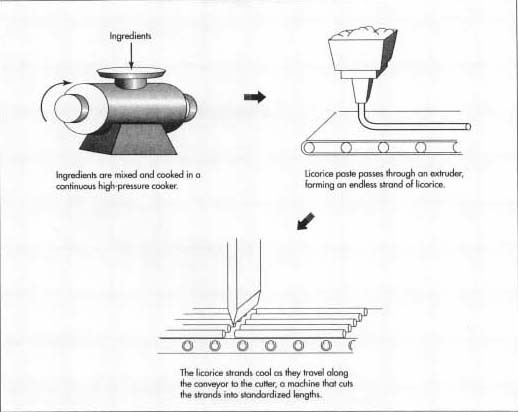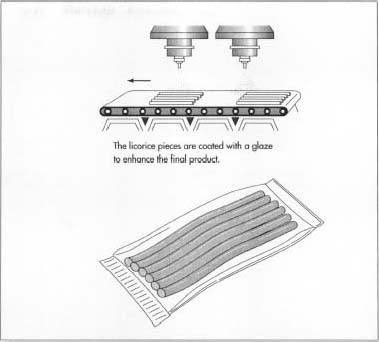Licorice
Background
Licorice is a glossy, gelled candy with a semi-firm consistency that is flavored with licorice root extract. Typically, it is a moderately sweet candy, and is available in a variety of flavors such as black licorice, strawberry, cherry and chocolate. Currently, it is touted as a healthier snack food because it contains almost no fat per serving. It is made in a continuous process, which involves mixing and cooking, forming the candy, cutting it, and putting it in packaging. Licorice represents one of the oldest forms of candy with evidence suggesting it was made as early as the thirteenth century. It continues to be a popular product today making up a significant portion of the over $13 billion, annual non-chocolate candy market. It is anticipated that licorice manufacturers will try to increase yearly sales primarily by increasing the speed at which they can produce the candy.
History
Using sugar-refining techniques, Arabs first produced various types of lozenges for pharmaceutical applications. One type of lozenge was flavored with licorice, which is a native plant of the Mediterranean area. The Arab peoples believed that the licorice root had important medicinal uses. Evidence of this crude predecessor to the contemporary licorice candy suggests that licorice is one of the oldest types of candy known.
During the thirteenth century, licorice root extract was widely used as a medicine for coughs, sore throats, and congestion. It is likely that merchants who sold this medicine combined it with honey to produce the first true licorice candies. Later, when sugar was more readily available, it was used instead of honey. In the late Middle Ages, licorice pastilles, which were cast in rough molds were widely known. Extruded licorice candy is thought to have originated in Holland at the start of the seventeenth century. It became one of the standard confection products for candy producers when the candy industry developed in the mid-1800s.
Raw Materials
Experienced chemists and candy technologists develop licorice candy recipes. By using their knowledge of ingredient characteristics and production processes, they can create a variety of licorice candy types. The ingredients in these recipes are specifically chosen to provide desired characteristics such as texture, taste, and appearance. They are typically mixed together in water to create a homogenous blend, and then much of the water is evaporated off to produce a solid product. The primary ingredients include sweeteners and wheat flour. Other ingredients such as starches, preservatives, colorants, and flavorings are also important.
Sweeteners
Since licorice is a sweet candy, sweetening ingredients make up much of their composition. Sugar and corn syrup are two primary sweeteners. Sugar is sucrose, which is derived from beet and cane sugars. It is supplied as small, white crystals, which readily dissolve in water. Since sugar is not critical to the texture of the licorice, it can be less refined, reducing the cost of the licorice recipe. Corn syrup is typically used in combination with sugar in licorice candy. It is a

Flour
All the ingredients in licorice must be bound together to maintain a cohesive product. To accomplish this, candy technologists use wheat flour. Wheat flour is obtained by grinding wheat seeds into a powder. It is primarily composed of starch and protein which when combined with water creates a paste, called gluten, that can be stretched and rolled without breaking. These properties allow the finished licorice paste to be extruded into various sizes and shapes. The flour is also responsible for the licorice's shiny appearance because during licorice manufacture, the starch in the flour is gelatinized. It is typically incorporated into the licorice paste at about 25-40%.
Flavorants, colorants, and other ingredients
Many other ingredients are incorporated into a licorice recipe to produce the familiar candy. To give the candy flavor and color, licorice black juice is included at a level from 1.5-4%. Since this material is quite

Processing ingredients are important in licorice manufacturing. Cornstarch is a high molecular weight sugar polymer that can have a wide range of functions in a licorice recipe. While it can be a sweetener, texture stabilizer and a gelling agent, it is primarily used as a coating ingredient to prevent pieces of licorice from sticking together. Soybean oil may also be used in the production of licorice. It provides some flavoring but also acts as a suitable lubricant during processing. Although licorice contains a high concentration of sugar, there is still a potential for microbial contamination. To prevent this type of contamination, potassium sorbate is included as a preservative in some licorice recipes.
The Manufacturing
Process
Licorice manufacture begins with making a batch of licorice paste. The batch is then extruded through a nozzle, cooled, cut, and packaged automatically.
Creating the slurry
- 1 The conventional method of producing licorice begins by making a slurry of the ingredients in the recipe. Factory workers, known as compounders, make slurry batches by pouring, or pumping, the appropriate amount of raw materials into large, stainless steel mixing tanks. These tanks are equipped with mixing, steam heating, and water cooling capabilities, and can accommodate batch sizes of 1,000-2,000 lb (454-908 kg) or more. The mixers in these tanks must efficiently sweep the sidewalls to prevent burning of the batch. When the slurry passes quality control tests, it can be pumped to the continuous cooker.
Cooking
- 2 Using traditional techniques, the batches of licorice had to be cooked anywhere from two to four hours. Since the main objective of this cooking process was to reduce the moisture content of the slurry, a faster continuous process was developed. By using a continuous, high-pressure cooking method some manufacturers have cut the cooking time down to a few minutes. In one type of cooker, the slurry of licorice paste is pumped into a vertical evaporator tube, which is surrounded by a steam jacket. Revolving blades inside the tube cause a process of heat exchange (cooking) to occur between droplets of slurry and the cooker. This reduces the moisture level of the slurry, and creates a thin film of licorice candy, which is extruded through an outlet at the bottom of the tube. The candy accumulates in a semi-solid paste, which can then be pumped through an extruder.
Extrusion
- 3 As the product leaves the cooker, it is pumped through electrically-heated pipes to the extruding machine. The paste goes through the extruder and is expelled on a conveyor as an endless strand of licorice. It can come out in a wide variety of shapes including braids, straws, twists, shoestrings and ribbons to name a few. Currently, extruders can handle over 2,000 lb (908 kg) of licorice per hour.
Cutting
- 4 The licorice strands then travel along the conveyor to the cutter. As they move toward the cutter, they travel slow enough to cool to an appropriate temperature. This is important because it allows the candy to harden and set. When the licorice strands arrive at the cutter, they are cut "guillotine style" into pieces of a desired length.
Final coating and packaging
- 5 From the cutter, the licorice pieces are moved along the conveyor to the package equipment. Along the way, they may be further dried and coated with a special glaze, which enhances the product's shine and keeps the pieces from sticking together in the bag. At the packaging stage, the licorice is lined up and stacked. It is placed on a horizontal flow wrapper and when enough pieces are available, the plastic film package is wrapped around the licorice and sealed on both ends. The package is then moved to a stamping machine, which prints a manufacturing tracking code number on it, and then to a boxing machine. Multiple packages are put into individual boxes. The boxes are stacked on pallets and the pallets are shipped on trucks to the food distributor.
Quality Control
The first part of quality control begins with the testing of incoming raw materials. Quality control lab technicians evaluate each ingredient prior to use to ensure that they conform to specifications. Sensory characteristics such as appearance, color, odor, and flavor are all checked. Other characteristics may also be examined such as viscosity of liquids, particle size of solids, and moisture content. Manufacturers depend on these tests to ensure that the ingredients they use will produce a consistent quality batch of licorice.
Beyond testing of the initial ingredients, quality tests are also run on the licorice paste. This includes pH, viscosity, and appearance testing, but it also includes an evaluation of the gelatinization of the batch. It turns out that the quality of the licorice paste is dependent on the extent to which starch gelatinization takes place. If the batch has fully gelatinized, it will have a good gloss and hold the production count-lines. A partially gelatinized batch will have a cleaner bite. Since both of these properties are desired, the final batch must be tested to ensure that just the right amount of gelatinization has taken place.
During production, quality control technicians check physical aspects of the extruded candy. The usual method of testing is to compare the newly-made product to an established standard. For example, the color of a randomly sampled licorice stick is compared to a standard licorice that was produced during product development. Other qualities of this sample such as taste, texture, and odor are evaluated by groups of sensory panelists. These are people who are specially trained to notice small differences in tactile properties. Additionally, many instrumental tests developed by the confectionery industry over the years are also performed to complement tests performed by humans.
The Future
The focus of research for licorice producers will be on developing faster, more efficient production methods. Most manufacturers have shifted away from the conventional method to a continuous process because the old batch method is slow and requires too much labor. To reduce manufacturing times, new cookers may be developed in the future. Another way to reduce times is by developing new licorice recipes. These recipes will use substitution ingredients, which can stabilize texture, extend shelf life while still reducing processing times and maintaining a desirable candy taste.
Where to Loarn More
Books
Alikonis, Justin. Candy Technology. Westport: AVI Publishing Co., 1979.
Booth, R. Gordon. Snack Food. New York: Van Nostrand Reinhold, 1990.
Macrae, R. et. al., editors. Encyclopedia of Food Science, Food Technology and Nutrition. San Diego: Academic Press, 1993.
Periodicals
Deis, Ronald. "Candy Creations with Starch and Its Derivatives." Food Product Design (September 1997): 73-88.
— Perry Romanowski